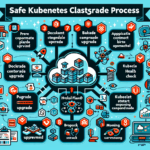Backing up and restoring Kubernetes configurations is a critical task to ensure business continuity and disaster recovery. Here’s how you can approach it:
Backup Kubernetes Configurations
Kubernetes configurations are primarily stored in etcd, the key-value store that Kubernetes uses as its backing store. Additionally, you may want to back up application manifests, custom resource definitions (CRDs), and other cluster-level configurations. Here’s a step-by-step guide:
1. Backup etcd Data
etcd contains all the cluster state and configurations, such as secrets, deployments, services, and more. Backing up etcd is essential for a full cluster recovery.
Steps:
– Connect to the etcd instance running in the control plane.
– Use the etcdctl tool to take a snapshot:
bash
ETCDCTL_API=3 etcdctl \
--endpoints=https://127.0.0.1:2379 \
--cert=/etc/kubernetes/pki/etcd/server.crt \
--key=/etc/kubernetes/pki/etcd/server.key \
--cacert=/etc/kubernetes/pki/etcd/ca.crt \
snapshot save /path/to/backup/etcd-snapshot.db
Replace /path/to/backup/etcd-snapshot.db with the desired path to store the backup file.
- Automate backups: Schedule periodic backups using a cron job or systemd timer.
2. Backup Kubernetes YAML Manifests
In addition to etcd, you should back up the YAML manifests for your workloads (e.g., deployments, services, ingresses).
Steps:
– Export resources using kubectl:
bash
kubectl get all --all-namespaces -o yaml > all-resources-backup.yaml
kubectl get crd -o yaml > crds-backup.yaml
– Store these files in a version-controlled system like Git or a backup location.
3. Backup Secrets
Secrets are stored in etcd but are encrypted. You can export them for backup purposes:
bash
kubectl get secrets --all-namespaces -o yaml > secrets-backup.yaml
Be careful with security; encrypt these backups when storing them.
4. Consider a Kubernetes Backup Tool
Several tools can automate backups and provide advanced features:
– Velero: Open-source solution for backing up and restoring Kubernetes resources and persistent volumes.
– Kasten K10: A commercial backup solution for Kubernetes.
– Stash: A Kubernetes-native backup solution.
These tools can simplify the process and also handle persistent volume backups.
Restore Kubernetes Configurations
Restoring Kubernetes configurations involves rehydrating etcd, reapplying resource YAML manifests, and recovering persistent volumes if needed.
1. Restore etcd Data
- Stop the Kubernetes control plane components (e.g., kube-apiserver, kube-scheduler, kube-controller-manager).
- Restore the etcd snapshot:
bash
ETCDCTL_API=3 etcdctl snapshot restore /path/to/backup/etcd-snapshot.db \
--data-dir /var/lib/etcd
Replace/var/lib/etcdwith the directory where etcd stores its data. - Restart the control plane components.
2. Reapply Kubernetes Manifests
- Reapply backed-up YAML manifests:
bash
kubectl apply -f all-resources-backup.yaml
kubectl apply -f crds-backup.yaml
kubectl apply -f secrets-backup.yaml
3. Restore Persistent Volumes
- If using tools like Velero or Kasten, follow their documentation to restore persistent volumes.
- If manually restoring, ensure that the underlying storage (e.g., NFS, Ceph) is intact and mount the volumes to the respective pods.
4. Verify Cluster State
- Check the cluster health:
bash
kubectl get nodes
kubectl get pods --all-namespaces - Validate that workloads are running and data integrity is intact.
Best Practices
- Automate Backup Process: Use tools like Velero or cron jobs to automate backups.
- Secure Backup Files: Encrypt sensitive backups (e.g., secrets, etcd snapshots) and store them securely.
- Test Restores Regularly: Periodically test the restore process to ensure backups are usable.
- Version Control for Manifests: Store Kubernetes manifests in Git or another version-controlled system for easy tracking.
- Document the Process: Create and maintain documentation for backup and restore procedures.
Would you like additional guidance on backup tools or specific configurations for your environment?


